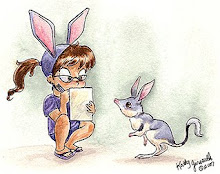 The Golden-rumped Elephant Shrew, Rhynchocyon chrysopygus, is one of the largest species of shrew. These rabbit-sized creatures have long flexible snouts; under their bright golden rump patch is a thickened layer of skin that may protect against bites of both predators and rival elephant shrews. This animal is found in a very limited, and shrinking, habitat in Kenya; golden-rumped elephant shews' numbers are in decline due to deforestation.
The Golden-rumped Elephant Shrew, Rhynchocyon chrysopygus, is one of the largest species of shrew. These rabbit-sized creatures have long flexible snouts; under their bright golden rump patch is a thickened layer of skin that may protect against bites of both predators and rival elephant shrews. This animal is found in a very limited, and shrinking, habitat in Kenya; golden-rumped elephant shews' numbers are in decline due to deforestation.
Saturday, November 24, 2007
Golden-rumped Elephant Shrew
 The Golden-rumped Elephant Shrew, Rhynchocyon chrysopygus, is one of the largest species of shrew. These rabbit-sized creatures have long flexible snouts; under their bright golden rump patch is a thickened layer of skin that may protect against bites of both predators and rival elephant shrews. This animal is found in a very limited, and shrinking, habitat in Kenya; golden-rumped elephant shews' numbers are in decline due to deforestation.
The Golden-rumped Elephant Shrew, Rhynchocyon chrysopygus, is one of the largest species of shrew. These rabbit-sized creatures have long flexible snouts; under their bright golden rump patch is a thickened layer of skin that may protect against bites of both predators and rival elephant shrews. This animal is found in a very limited, and shrinking, habitat in Kenya; golden-rumped elephant shews' numbers are in decline due to deforestation.
Friday, November 16, 2007
Painting the Long-eared Jerboa
 I had a very hard time with this jerboa. I could only find about 5 reference photos. I try to watch video of an animal if I'm unfamiliar with its structure, to see how it moves and get a better idea of it as a 3D critter. The 2-second clip of a long-eared jerboa did not help at all. I did some other sketches of different poses, but I'm not very happy with how any turned out. I may come back and redo this one when I finish all the others. I also have a hard time mixing the correct color of this thing; that weird grayish-brownish color. It kept coming out greenish. Oh well, can't win 'em all!
I had a very hard time with this jerboa. I could only find about 5 reference photos. I try to watch video of an animal if I'm unfamiliar with its structure, to see how it moves and get a better idea of it as a 3D critter. The 2-second clip of a long-eared jerboa did not help at all. I did some other sketches of different poses, but I'm not very happy with how any turned out. I may come back and redo this one when I finish all the others. I also have a hard time mixing the correct color of this thing; that weird grayish-brownish color. It kept coming out greenish. Oh well, can't win 'em all!It doesn't help much that my cat was sitting on my desk the whole time I painted this. I sit by a window to get some natural light, and my cat likes to look out the window at birds, so her tail was whipping around in my paint and over my paper, and she kept trying to drink my paint water.
Long-eared Jerboa
Saturday, November 10, 2007
Painting the Bactrian Camel
 I'm proud of myself; this picture was heavily referenced from sketches of camels at the San Diego Zoo. I also had photos I took of cute baby camels at the fair to help with textures. I had to paint the shadows with purple instead of blue, so it wouldn't look too green.
I'm proud of myself; this picture was heavily referenced from sketches of camels at the San Diego Zoo. I also had photos I took of cute baby camels at the fair to help with textures. I had to paint the shadows with purple instead of blue, so it wouldn't look too green.My only regret is that in this pose, you can't see the camel's neato feet. I was surprised that bactrians are as endangered as they are, with all the domesticated ones around the world. Some bactrian camels have fun hairstyles, so I made mine have a cool 'do too.

Monday, November 5, 2007
Bactrian Camel

Wild Bactrian Camels, Camelus bactrianus, live in the harsh Gobi Desert. These animals have smaller, more conical humps than domestic camels; they're also less bulky. Their long eyelashes and sealable nostrils keep out the frequent sandstorms. There are over a million domesticated bactrians, but the wild variety is critically endangered. The camels, numbering less than 1,000, are threatened by resource and habitat competition with livestock and hunting.
Subscribe to:
Posts (Atom)


